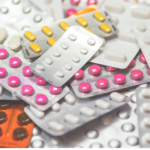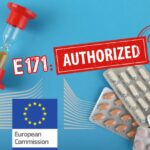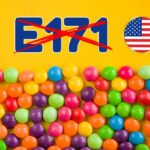
Nanos and drugs

Nanos and drugs
By the AVICENN team – Last updated April 2025
Nanos in drugs: research and applications
Reliable, up-to-date information on nanotechnology research and applications in the pharmaceuticals sector is scarce1See the references listed at the bottom of the page in the “Elsewhere on the web” section for more details.
The French National Agency for the Safety of Medicines and Health Products (ANSM) published a report in 2011 on the Biological Evaluation of medical devices containing nanomaterials.
Followed by silence… it took nearly ten years to obtain a new report, composed of information that was unfortunately relatively dated:
- Article 60 of the law on the modernization of our health system stated that the government would submit a report on nanomaterials in drugs and medical devices to Parliament in the summer of 2017.
- While the Department of Health announced its upcoming release in July 2018, by mid-2020, we still had no record of the report.
- Despite its numerous reminders to the Ministry of Health, AVICENN did not manage to get more information, except that the report, carried out by ANSM, was being finalized and in the process of inter-ministerial validation… but this since at least December 2017…
- In July 2020, AVICENN therefore sent a registered letter to the Prime Minister and the Minister of Solidarity and Health to demand the release of the government report on nanomaterials in drugs and medical devices that should have been made public three years before.
- The report received on August 3, 2020 has no date or author(s), no details on methodology, has mostly old references and major limitations.
The recommendations of the latest ANSM report are nevertheless interesting and remain more relevant than ever:
- developments in standardization and regulation for better identification and evaluation of nanomedicines and medical devices
- modifications of the R-nano register (convergent with the demands of the precautionary and prevention actors)
- increased involvement of ANSM on the subject
- etc.
(Un)desired presence of nanoparticles in drugs
E71 in the spotlight
E171, banned in food since 2020, is present in many medicines2– In 2017, Que Choisir revealed that “4,000 drugs contain the dye E171” (composed in part of titanium dioxide nanoparticles).
– In 2018, 60 Millions de Consommateurs brought confirmation through tests of the presence of these nanoparticles in 6 widely used drugs: Efferalgan – Upsa, Spasfon – Teva, Zyrtecset – UCB Pharma, Nurofen – Reckitt Benckiser, Doliprane enfant – Sanofi, Euphytose – Bayer.
– In December 2021, in its exclusive issue on nanoparticles, Kali magazine published a list of the 800 most prescribed drugs that contain titanium dioxide.
This excipient, composed of titanium dioxide nanoparticles, has no therapeutic purpose; it is used as a colorant and/or opacifier in the film coating of tablets or capsules for its protective properties against UV radiation. It is therefore to be dissociated from “nano-drugs”, which are voluntarily designed on a nano-scale with the aim of crossing physiological barriers and bringing active substances more rapidly and/or more precisely into the body.
Many voices in recent years have been calling for the removal of E171 from medicines.
Thomas Borel, Director of Scientific Affairs at LEEM, the professional organization of drug companies in France, believes that “the excipient E171 ensures the stability of the drug” and that it is therefore “indispensable” for example, to ensure protection and ingestion of the drug3Cf. Why titanium dioxide has been banned from plates, but not toothpastes, Challenges, June 7, 2019 and “Removing E171 from drugs would be extremely burdensome,” Rose Up, August 28, 2019.
That said, brands are now promoting TiO2-free drug coatings4See for example Biogrund’s marketing campaign launched in March 2019:
– Challenges of TiO2 free film coatings, March 25, 2019
– Titanium dioxide (TiO2) – a critical excipient, 19 March 2019
– Replacement of titanium dioxide (TiO2) in tablet film coatings
– Are you facing the challenge of replacing TiO₂ in your coating formulations? and in 2019, Sanofi confirmed that it was considering substituting titanium dioxide in its drugs5See speech by René Labatut, Vice President, Technology Innovation Strategy, Sanofi, at the NanoResp Forum, Drugs and vaccines: what are their nanoparticles for?”, May 20, 2019. In May 2018, the TiO2 nanoparticle management plan implemented by Sanofi had been the subject of a presentation at the SOFHYT forum on emerging risks.. In subsequent years, this led to the effective elimination of E171 from Doliprane, among other drugs.
In February 2025, the European Commission should decide whether to delete – or if not, to extend for a period to be determined – the authorization for the use of titanium dioxide (E171) in medicinal products6cf. recitals 14 to 18 and article 3 of European Regulation 2022/63. Several weeks later, still nothing… : to be continued!
Other nanoparticles of concern in drugs
Titanium dioxide (E171) nanoparticles are not the only problem. The safety of other nanoparticles also present in drugs is questionable – in particular those used as colorants (iron oxides in particular7In December 2022, AVICENN’s report Searching for [nanos] in every day products noted the presence of nanoparticles of titanium dioxide and iron oxides in Bayer’s drug Xarelto) or silica. Will the work carried out by ANSES on the risks of nanos in food quickly shed light on these questions?
Stay tuned…
– In French :
- AVICENN for VeilleNanos, Nanos in medicines and health products: recommendations for better regulation, 2 March 2023
- LNE, Workshop on nanomedicines and nanomaterial-based medical devices, June 30, 2022
- European Directorate for the Quality of Medicines and Healthcare, Quality requirements for nanomedicines: what role for the European Pharmacopoeia, 7-8 June 2022
- Que Choisir, Ban on titanium dioxide – The European Medicines Agency puts the brakes on, 28 October 2021
- CNRS Ile de France, Gif sur Yvette, Nanomedicines, on a small scale for large applications, 10 June 2021
- Daily Geek Show, These drug nanoparticles show particular promise against cancer, January 4, 2021
- The Conversation, What happens to gold nanoparticles from drugs in our bodies, Florence Gazeau and Florent Carn, March 3, 2020
- Le Nouvelliste, Environnement: les nanoparticules de médicaments risquent de se disperser dans la nature, January 2020
- Institut Galien, Université Paris-Sud, Des nanos plein les bronches, Video, “Des idées plein la Tech”, November 2019
- Academy of Sciences – National Academy of Pharmacy, Nanomedicines: where do we come from and where are we going?”, October 16, 2019
- NanoResp Forum, Drugs and vaccines: what are their nanoparticles for, May 20, 2019
- AVICENN, After food, the suspension of titanium dioxide in toothpastes and medicines?, Veillenanos, 28 March 2019
- Saadia Kerdine-Romer, Hervé Hillaireau (Labex LERMIT), Nanoparticles are promising drug carriers, but what about their toxicity, especially on the immune level, Life Sciences UPSaclay, March 1, 2019
- Arnaud Pallotta and Jordan Beurton, Nanoparticles and drugs, Pint of Science Festival, Laboratoire Cible Thérapeutiques et Formulation – CITHÉFOR (Université de Lorraine), Nancy, March 27, 2019
- Bourse direct, Sanofi partners with Lyon-based startup to produce innovative oncology nanoparticle, Feb. 20, 2019
- APMnews, ANSM recommends regulatory changes for nanomaterials in health products (report), Feb. 13, 2019
- University of Lorraine, Nanoparticles in drugs: how to ensure quality control, The Conversation, December 17, 2018
- CNRS, A nanomaterial delivers drugs under infrared light, Strasbourg Institute of Physics and Chemistry of Materials (IPCMS, CNRS/University of Strasbourg) and Institute of Chemistry and Processes for Energy, Environment and Health (ICPEES, CNRS/University of Strasbourg), November 26, 2018
- Fiva, Blueberry Therapeutics raised about $12.7 million to develop nano-drugs that treat skin and nail infections, August 2018 (Investors included China Medical Venture Investment and A & B Company, a Hong Kong-based health technology company)
- Ministry of Solidarity and Health, Risks related to the presence of titanium dioxide nanoparticles in drugs, answer to the written question of Senator François Bonhomme, July 2018
- Poirot-Mazères I, Medicines in nanoparticulate form and medical devices containing nanomaterials: new deal for the benefit-risk balance, in: Journées Louis Dubouis, The new challenges of the pharmaceutical policy of the European Union. For safe, innovative and accessible medicines, Toulouse Capitole University, May 23-24, 2018
- Allô docteurs ?, Levothyrox: metal nanoparticles in the new formula?, 2 May 2018
- Cordis, Nanoparticle drug delivery to combat antibiotic resistance, Cyclon Hit, April 30, 2018
- 60 millions de consommateurs, Médicaments : des nanos dans l’Efferalgan et le Nurofen, 22 March 2018
- LNE, Nanomaterials and drugs: how to characterize and measure them, Webinar, February 6, 2018
- Que Choisir, Nanoparticles – Attention, elles se cachent partout, Monthly No. 566, February 2018
- ANSM, Nanomaterials in medicines and medical devices, date ? 2017 ? (report obtained by AVICENN on August 3, 2020)
- European Parliament and Council of the European Union, European Regulation on Medical Devices No. 2017/745, April 5, 2017:
- Devices are designed and manufactured to minimize the risks associated with the size and properties of particles that are released or are likely to be released into the patient’s or user’s body, unless they come into contact only with intact skin. Special attention is given to nanomaterials.
- All devices that incorporate or are made of a nanomaterial are covered:
- Class III if they have a medium or high internal exposure potential,
- Class IIb if they have a low potential for internal exposure, and
- Class IIa if they have negligible internal exposure potential.
- UFC Que Choisir, Colorant E171 Les médicaments aussi!”, February 4, 2017
- AVICENN, What vigilance regarding nanomaterials in drugs and medical devices, veillenanos.fr, July 2016
- Michèle Rivasi, The Commission has no exhaustive list of nanomaterials present in medicines authorized on European soil, 3 September 2015
- LNE, Nanoparticles and Medical Devices: How to meet the regulations for material characterization, Webinar, December 11, 2014
- LEEM, Applications of nanotechnology to medicine, February 13, 2014
- Afssaps (now ANSM), Recommendations on the toxicological evaluation of nanoparticulate drugs, October 2011
- Afssaps (now ANSM), Biological evaluation of medical devices containing nanomaterials, Scientific report, February 2011
– In English:
- The European Nanomedicine Characterisation Laboratory (EUNCL) website
- Engineers develop a way to mass manufacture nanoparticles that deliver cancer drugs directly to tumors, MIT News, Massachusetts Institute of Technology, 3 April 2025
- Orthogonal and complementary measurements of properties of drug products containing nanomaterials, Simon CG et al, Journal of Controlled Release, 354: 120-127, February 2023
- Squalene-based multidrug nanoparticles for improved mitigation of uncontrolled inflammation, Dormont F et al, Science Advances, 27 April 2020
- Measuring nanoparticles in medicinal products, EU Science Hub (JRC), 10 May 2019
- Nanopilot: “A Pilot Plant for the Production of Polymer-based Nanopharmaceuticals in Compliance with GMP”
- Nano-pharmaceutics and Drug Delivery: Challenges and Breakthroughs, Dublin, August 16-17, 2018
- Smart nanomaterials for drug delivery: past, present and future, Satapathi S, International Journal of Drug Research and Technology, [S .l.], 8(1), February 2018
- Characterization of nanoparticles intended for drug delivery, Scott E. McNeil, Editor. Methods in Molecular Biology. Vol. 1628, Humana Press, New York, NY. ISBN: 978-1-4939-7350-7, 2018
- FDA, “Drug Products, Including Biological Products, that Contain Nanomaterials” – Guidance for Industry – Draft guidance, December 2017 (submitted for comment until March 2018).
- Nature Nanotechnology, The evolving landscape of drug products containing nanomaterials in the United States, D’Mello SR et al, 2017
Any questions or comments? This information sheet compiled by AVICENN is intended to be completed and updated. Please feel free to contribute.
Our information sheets to go further
Upcoming Nano Agenda

- Scientific conference
- 23rd International conference on Advanced Nanomaterials
- From July 23 to July 25, 2025
- Website: www.advanced-nanomaterials-conference.com

- E-learning program: awareness-raising for personnel who come into contact with nanomaterials during research, formulation, production, maintenance, cleaning, upkeep, etc., as well as safety coordinators or engineers, facility managers, heads of laboratories where nanoparticles are handled.
- Organizers: INSTN Grenoble (CEA)
- On the program:
- 1 – Introduction, definition and characteristics of nanomaterials
- 2 – Toxicity of nanomaterials: the state of knowledge
- 3 – Metrology and characterization of nanomaterials
- 4 – Prevention and protection against nanomaterials in the workplace
- 5 – Quiz: assessment of learning outcomes
- The 2-hour course can be viewed for one month from the date of registration.
- Website: https://instn.cea.fr/…risques-lies-aux-nanomateriaux…

- E-learning program: awareness-raising for personnel who come into contact with nanomaterials during research, formulation, production, maintenance, cleaning, upkeep, etc., as well as safety coordinators or engineers, facility managers, heads of laboratories where nanoparticles are handled.
- Organizers: INSTN Grenoble (CEA)
- On the program:
- 1 – Introduction, definition and characteristics of nanomaterials
- 2 – Toxicity of nanomaterials: the state of knowledge
- 3 – Metrology and characterization of nanomaterials
- 4 – Prevention and protection against nanomaterials in the workplace
- 5 – Quiz: assessment of learning outcomes
- The 2-hour course can be viewed for one month from the date of registration.
- Website: https://instn.cea.fr/…risques-lies-aux-nanomateriaux…
This sheet was originally created in February 2019
Notes and references
- 1See the references listed at the bottom of the page in the “Elsewhere on the web” section for more details
- 2– In 2017, Que Choisir revealed that “4,000 drugs contain the dye E171” (composed in part of titanium dioxide nanoparticles).
– In 2018, 60 Millions de Consommateurs brought confirmation through tests of the presence of these nanoparticles in 6 widely used drugs: Efferalgan – Upsa, Spasfon – Teva, Zyrtecset – UCB Pharma, Nurofen – Reckitt Benckiser, Doliprane enfant – Sanofi, Euphytose – Bayer.
– In December 2021, in its exclusive issue on nanoparticles, Kali magazine published a list of the 800 most prescribed drugs that contain titanium dioxide - 3Cf. Why titanium dioxide has been banned from plates, but not toothpastes, Challenges, June 7, 2019 and “Removing E171 from drugs would be extremely burdensome,” Rose Up, August 28, 2019
- 4See for example Biogrund’s marketing campaign launched in March 2019:
– Challenges of TiO2 free film coatings, March 25, 2019
– Titanium dioxide (TiO2) – a critical excipient, 19 March 2019
– Replacement of titanium dioxide (TiO2) in tablet film coatings
– Are you facing the challenge of replacing TiO₂ in your coating formulations? - 5See speech by René Labatut, Vice President, Technology Innovation Strategy, Sanofi, at the NanoResp Forum, Drugs and vaccines: what are their nanoparticles for?”, May 20, 2019. In May 2018, the TiO2 nanoparticle management plan implemented by Sanofi had been the subject of a presentation at the SOFHYT forum on emerging risks.
- 6cf. recitals 14 to 18 and article 3 of European Regulation 2022/63
- 7In December 2022, AVICENN’s report Searching for [nanos] in every day products noted the presence of nanoparticles of titanium dioxide and iron oxides in Bayer’s drug Xarelto






